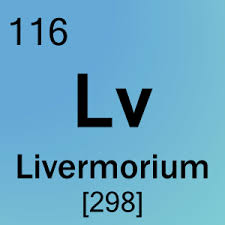Today is Livermorium Day. One year ago, element 116 was officially named livermorium (Lv) by the International Union of Pure and Applied Chemists (IUPAC). The name was chosen to honor the work of contributing scientists from Lawrence Livermore National Laboratory (LLNL) and the Lab's hometown, Livermore, California. Before the official name was given, livermorium was known as ununhexium.
 Livermorium - Source sciencenotes.org
Livermorium - Source sciencenotes.org
Working collaboratively, U.S. and Russian scientists discovered Livermorium in 2000 in a lab in Dubna, Russia. Note that the process of verifying the scientists' work and naming the element took 13 years to complete. Also discovered by scientists at the Dubna lab is the element flevorium, Fl 114, named after Flerov Laboratory of Nuclear Rections.
In honor of livermorium, two of my classes and an AP chemistry class from Granada High School were invited to participate in a Google Hangout event and talk with scientists from LLNL and the mayor of Livermore, John Marchand.
The goal of the program is to foster an appreciation for scientific discovery.
Students learned that only a few atoms of livermorium, lasting less than a second, were produced in the experiment. Livermorium is classified as a synthetic superheavy element. Because of quick decay, the physical properties and applications are yet to be discovered, perhaps by current students.
The connections between engineering and science were discussed. Mayor Marchand stated, "Engineers and chemists are trained differently, to think differently. Chemists work at the molecular level and build their way up. Engineers start with something big and typically work their way down to the individual components. Collaborate to understand to create and build something, coming from two different directions to solve a problem."
One of the discovery team scientists, Mark Stoyer, last year described to my engineering class how a wide variety of engineers might be involved in a research project. Expertise from mechanical, industrial, material, and electrical engineers may be required to design, build, and implement, and troubleshoot lab equipment.
Mayor Marchand, himself a trained chemist, advised students to study a variety of classes and sciences. "Pay attention. Broaden your horizons as much as you can. Take classes in many fields. You never know what you're interested in unless you're exposed to them."
The panel was asked why look for new elements, especially if their existence is fleeting. Their reply: The pursuit of knowledge through scientific research is, by itself, a worthy goal.
The work of PolarTREC teachers and researchers echoes this thought. Why study seemingly isolated phenomena such as neutrinos on Antarctica, pollinators on Greenland, and hibernating squirrels in the Arctic? All pieces are part of a larger picture, part of Earth's interconnected systems. Understanding event the smallest parts of this picture may lead to discoveries unknown.
The archived Google Hangout can be found at

